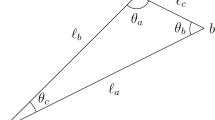Abstract
We consider the problem of finding a measure from the given values of its logarithmic potential on the support. It is well known that a solution to this problem is given by the generalized Laplacian. The case of our main interest is when the support is contained in a rectifiable curve, and the measure is absolutely continuous with respect to the arclength on this curve. Then the generalized Laplacian is expressed by a sum of normal derivatives of the potential. Such a representation is already available for smooth curves, and we show it holds for any rectifiable curve in the plane. We also relax the assumptions imposed on the potential.
Finding a measure from its potential often leads to another closely related problem of solving a singular integral equation with Cauchy kernel. The theory of such equations is well developed for smooth curves. We generalize this theory to the class of Ahlfors regular curves and arcs, and characterize the bounded solutions on arcs.
Similar content being viewed by others
References
S. Bochner, Green-Goursat theorem, Math. Zeit. 63 (1955), 230–242.
G. Bertrand, Equations de Fredholm à intégrales principales au sens de Cauchy, Comptes Rendus, Paris 172 (1921), 1458–1461.
Yu. D. Burago and V. G. Maz’ya, Potential Theory and Function Theory for Irregular Regions, (Seminars in Mathematics, V. A. Steklov Mathematical Institute, Leningrad, Vol. 3), Consultants Bureau, New York, 1969.
Yu. D. Burago, V. G. Maz’ya and V. D. Sapozhnikova, On the theory of simple and double-layer potentials for domains with irregular boundaries, in: V. I. Smirnov (ed.), Boundary Value Problems and Integral Equations, Consultants Bureau, New York, 1968, 1–30.
P. J. Cohen, On Green’s theorem, Proc. Amer. Math. Soc. 10 (1959), 109–112.
I. I. Danilyuk, Nonregular Boundary Value Problems in the Plane, Nauka, Moscow, 1975 (in Russian).
G. David, Opérateurs intégraux singuliers sur certaines courbes du plan complexe, Ann. Sci. École Norm. Sup. 17 (1984), 157–189.
P. Deift, T. Kreicherbauer and K. T.-R. McLaughlin, New results on the equilibrium measure for logarithmic potentials in the presence of an external field, J. Approx. Theory 95 (1998), 388–475.
P. L. Duren, Theory of Hp Spaces, Dover, New York, 2000.
D. Gaier, Lectures on Complex Approximation, Birkhäuser, Boston, 1987.
G. M. Goluzin, Geometric Theory of Functions of a Complex Variable, Amer. Math. Soc., Providence, R.I., 1969.
E. G. Guseinov, The Plemelj-Privalov theorem for the generalized Hölder classes, Sb. Math. 75 (1993), 165–182.
W. K. Hayman and P. B. Kennedy, Subharmonic Functions, Academic Press, London, 1976.
B. V. Hvedelidze, Linear discontinuous boundary problems in the theory of functions, singular integral equations and some of their applications, Trudy Tbiliss. Mat. Inst. Razmadze 23 (1956), 3–158 (in Russian).
O. D. Kellogg, Foundations of Potential Theory, Dover, New York, 1954.
A. Martínez-Finkelshtein and E. B. Saff, Asymptotic properties of Heine-Stieltjes and Van Vleck polynomials, J. Approx. Theory 118 (2002), 131–151.
N. I. Muskhelishvili, Singular Integral Equations, Dover, New York, 1992.
J. Plemelj, Potentialtheoretische Untersuchungen, Preisschr. Jablonowskische Ges. 40, Nr. 16, Leipzig, 1911.
J. Plemelj, Ein Ergänzungssatz zur Cauchyschen Integraldarstellung analytischer Funktionen, Randwerte betreffend, Monatsh. Math. Phys. 19 (1908), 205–210.
Ch. Pommerenke, Boundary Behaviour of Conformal Maps, Springer-Verlag, Berlin, 1992.
I. E. Pritsker, The Gelfond-Schnirelman method in prime number theory, Canad. J. Math. 57 (2005), 1080–1101.
I. E. Pritsker, Weighted energy problem on the unit circle, Constr. Approx. 23 (2006), 103–120.
I. I. Privalov, Boundary Properties of Analytic Functions, 2nd ed., Gosudarstv. Izdat. Tehn.-Teor. Lit., Moscow-Leningrad, 1950 (in Russian).
J. Radon, Über die Randwertaufgaben beim logarithmischen Potential, Sitzungsber. Akad. Wiss. Wien 128 (1920), 1123–1167.
T. Ransford, Potential Theory in the Complex Plane, Cambridge University Press, Cambridge, 1995.
V. V. Salaev, Direct and inverse estimates for the singular Cauchy integral along a closed curve, Math. Notes 19 (1976), 221–231.
V. V. Salaev, The singular Cauchy operator over an open curve. N. I. Muskhelishvili’s theorem, Azerbaidzhan. Gos. Univ. Uchen. Zap. Ser. Fiz.-Mat. Nauk 1 (1976), 45–52 (in Russian).
E. B. Saff and V. Totik, Logarithmic Potentials with External Fields, Springer-Verlag, Berlin, 1997.
V. L. Shapiro, On Green’s theorem, J. London Math. Soc. 32 (1957), 261–269.
L. Zalcman, Analyticity and the Pompeiu problem, Arch. Rational Mech. Anal. 47 (1972), 237–254.
Author information
Authors and Affiliations
Corresponding author
Additional information
Dedicated to Professor W. K. Hayman on his 80th birthday
Research was partially supported by the National Security Agency under grant H98230-06-1-0055, and by the Alexander von Humboldt Foundation.
Rights and permissions
About this article
Cite this article
Pritsker, I. How to Find a Measure from its Potential. Comput. Methods Funct. Theory 8, 597–614 (2008). https://doi.org/10.1007/BF03321707
Received:
Revised:
Published:
Issue Date:
DOI: https://doi.org/10.1007/BF03321707



